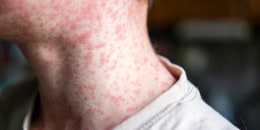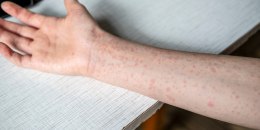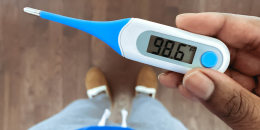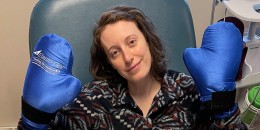Several measles outbreaks across the U.S. are sickening people this year — most who are unvaccinated — including in Texas, where state officials are reporting the worst outbreak in almost 30 years.
In fact, an unvaccinated school-age child has died of measles in West Texas, the first death in the outbreak and the first measles death in the U.S. since 2015. At least 22 people out of 159 cases have been hospitalized, according to the Texas Department of State Health Services.
The patients who were hospitalized were having trouble breathing and required treatment, such as supplemental oxygen, Dr. Lara Johnson, a pediatrician and the chief medical officer at Covenant Children’s Hospital in Lubbock, said during a news conference.
She estimated that her team has seen at least 20 children with measles since the outbreak started in late January. Several have needed intensive care. None were vaccinated against measles.
All of the recent Texas cases have been reported in the South Plains region, the majority in children. The epicenter of the outbreak is in Gaines County, where nearly 14% of kids between kindergarten and 12th grade have opted out of receiving at least one required vaccine. It's one of the highest exemption rates in the state. It's unclear how the Texas outbreak originated.
At least three other states have also reached outbreak status, which means they have reported three or more cases:
- New Mexico, which confirmed nine in Lea County, which borders Gaines County, Texas.
- Georgia, which reported at least three cases in metro Atlanta.
- New Jersey, which confirmed one case in an unvaccinated individual who recently traveled internationally, followed by two more in close contacts.
Oklahoma State Department of Health has also issued a health advisory to doctors to be on the lookout for cases even though the state, which borders Texas, has not confirmed any cases.
Other states with cases include:
- Rhode Island, with one confirmed a case in a young, unvaccinated child with international travel — the state’s first since 2013.
- Alaska, confirming one in January in an unvaccinated adult who traveled overseas.
- California, with one confirmed case, as of Feb. 15.
- New York has two cases in New York City and none outside the state.
- Kentucky has confirmed a case in an adult in Franklin County who had recently traveled internationally.
- Florida, where a student at a high school in Miami tested positive for measles, according to NBC Miami.
In all of 2024, there were 285 cases of measles in the United States, according to the U.S. Centers for Disease Control and Prevention. Within just the first two months of 2025, the country is already approaching half that number. In 2023, there were only 59 measles cases in the U.S.
As measles cases continue to rise, you may be wondering if you are safe — especially since measles starts with cold symptoms that mimic other viruses that circulate in the winter. But as the cold symptoms progress, one clue the illness is different from common respiratory viruses is a classic red rash.
Here’s what to know about measles symptoms, what a measles rash really looks like and the best ways to protect yourself and loved ones.
What are the first signs of measles?
Measles is considered one of the most contagious infectious diseases in the world, with approximately 9 out of every 10 people who are not immunized developing symptoms after exposure to an infected individual.
Measles has several stages of infection that occur over two to three weeks.
The incubation period, or the time between exposure to a disease and symptoms starting, is usually one to two weeks. Symptoms then develop in stages, lasting about 10 days in total. Recovery also progresses in phases.
The first symptoms of measles last two to three days and are non-specific and mild, including:
- Cough
- Runny nose
- Watery eyes
In the next phase, look for:
- White spots in the cheeks called Koplik spots.
- A red rash, usually three to five days after the first symptoms develop.
- A high fever as the rash starts to appear
- Muscle pain
- Sore throat
Usually the rash lasts about a week. You’ll know you’re recovering if:
- The rash gradually fades.
- The cough goes away.
- The skin peels.
Measles symptoms in adults versus kids
“Kids and adults will have a similar pattern of symptoms,” Dr. Linda Yancey, infectious disease specialist at Memorial Hermann Health System in Houston, Texas, tells TODAY.com.
But some children, especially those not up to date with their vaccines or younger than 5, are more likely to experience complications, such as ear infections, pneumonia and encephalitis, life-threatening inflammation in the brain.
Approximately one in five people with measles is hospitalized, according to the CDC.
What does a measles rash look like?
Two to four days after a fever, people classically develop a red, blotchy rash that starts on the face along the hairline and behind the ears and then spreads down to the rest of the body.
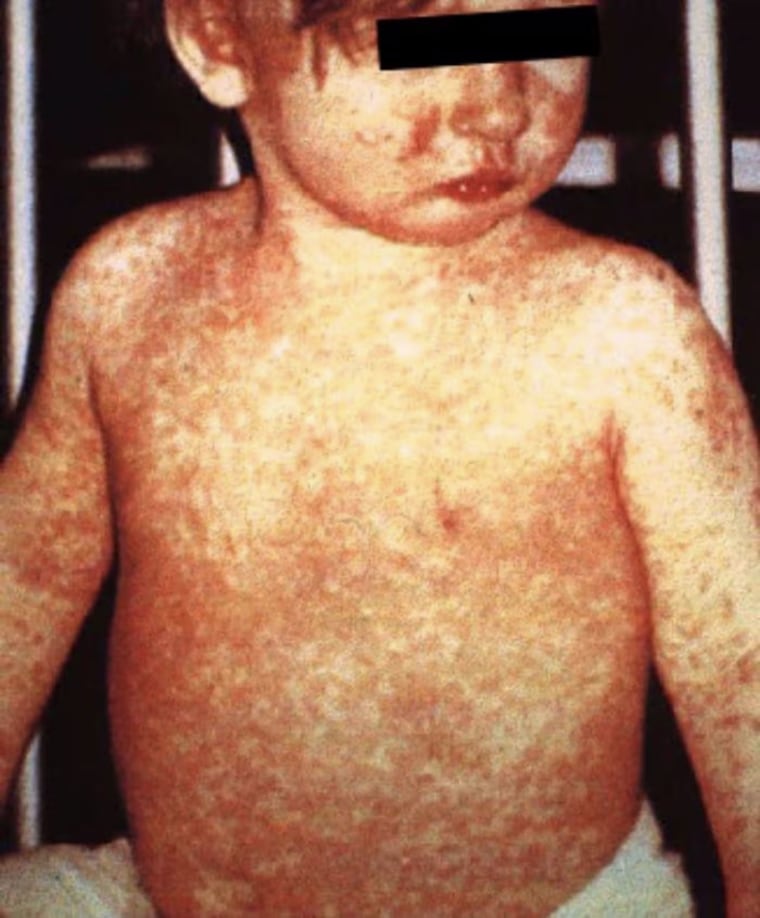
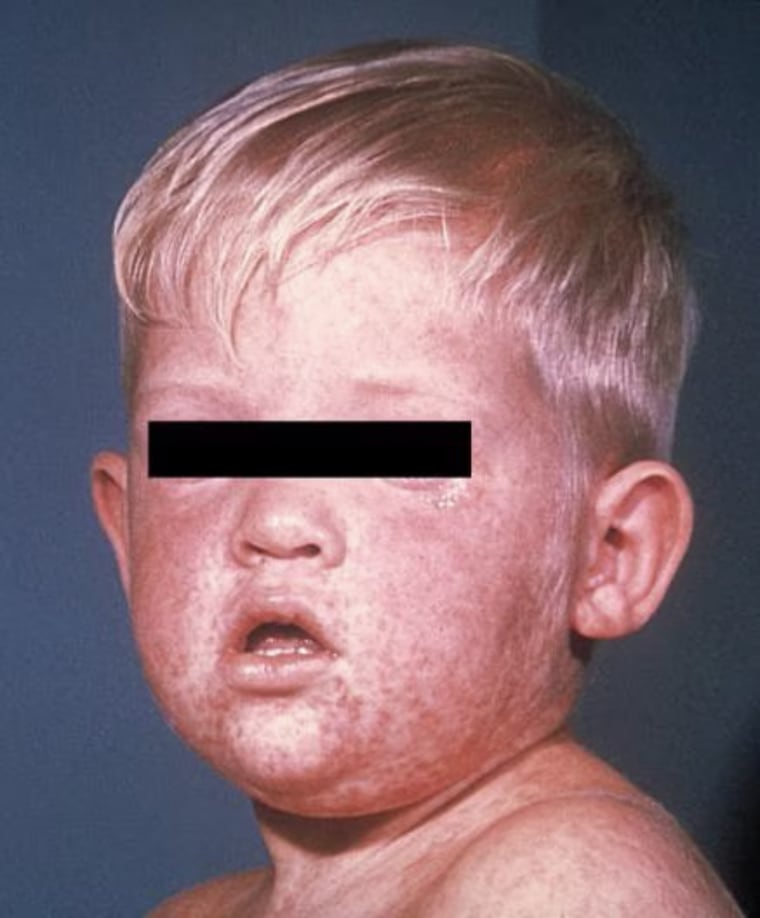
This rash starts as red spots in clusters (which gives the splotchy red appearance) but eventually coalesces into one big rash over several days. Some lesions may be flat while others feel more raised. The spots often blanch early on, meaning they turn pale or white when pressed, but as it progresses, they lose this characteristic.
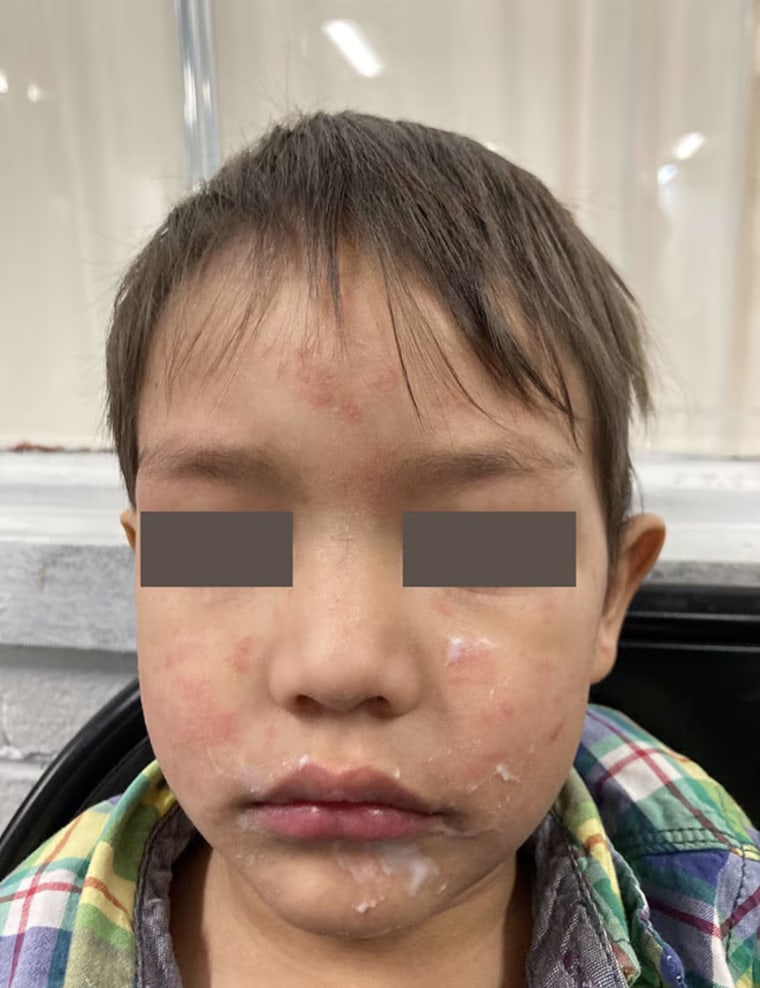
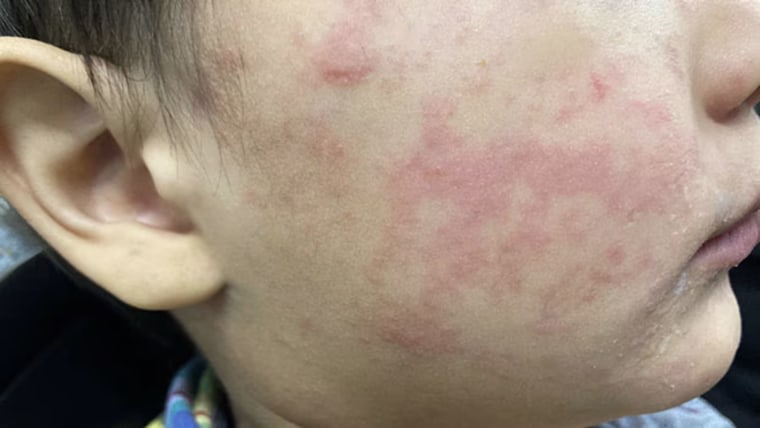
The rash may look different depending on skin tone, appearing brighter red on lighter skin individuals but more brownish-red or purplish on darker skin.
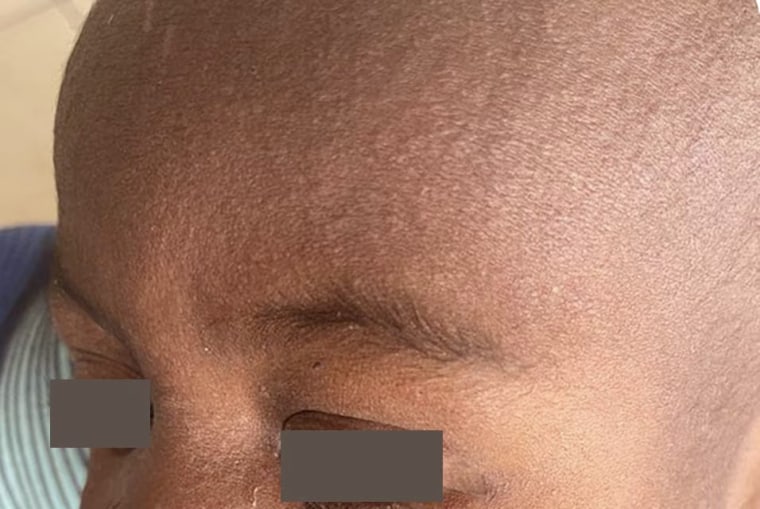

The rash usually lasts less than one week, fading in the same order it appears, leaving a brown-colored area (in lighter skinned individuals but not in those with darker skin), followed by fine peeling of the skin in the areas most affected.
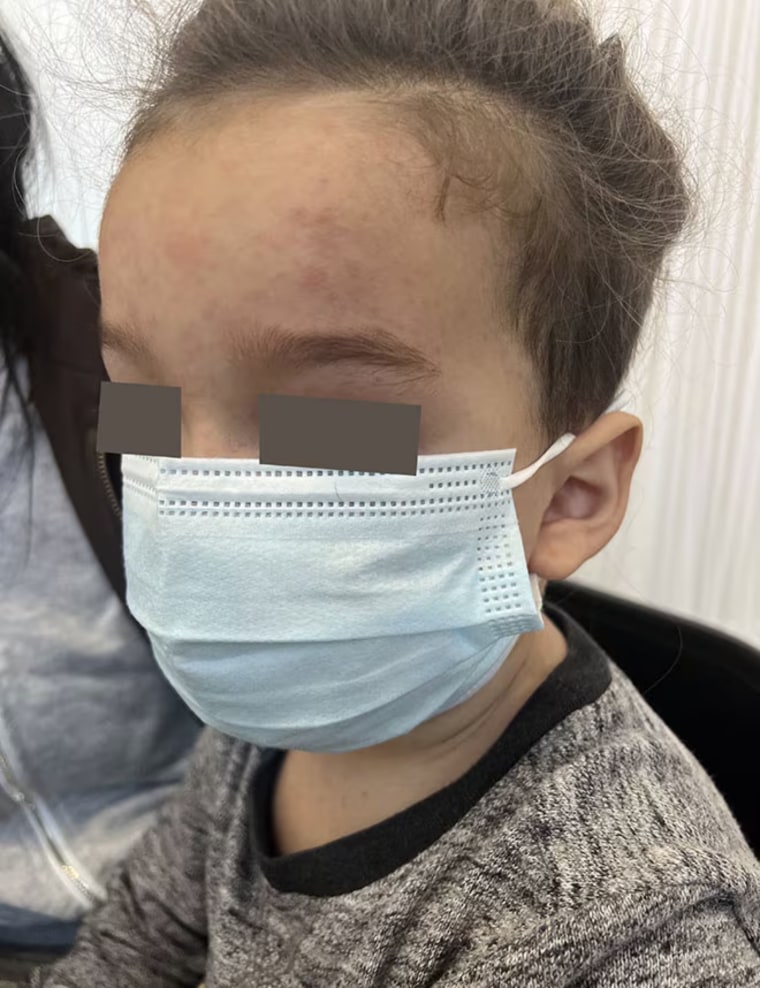
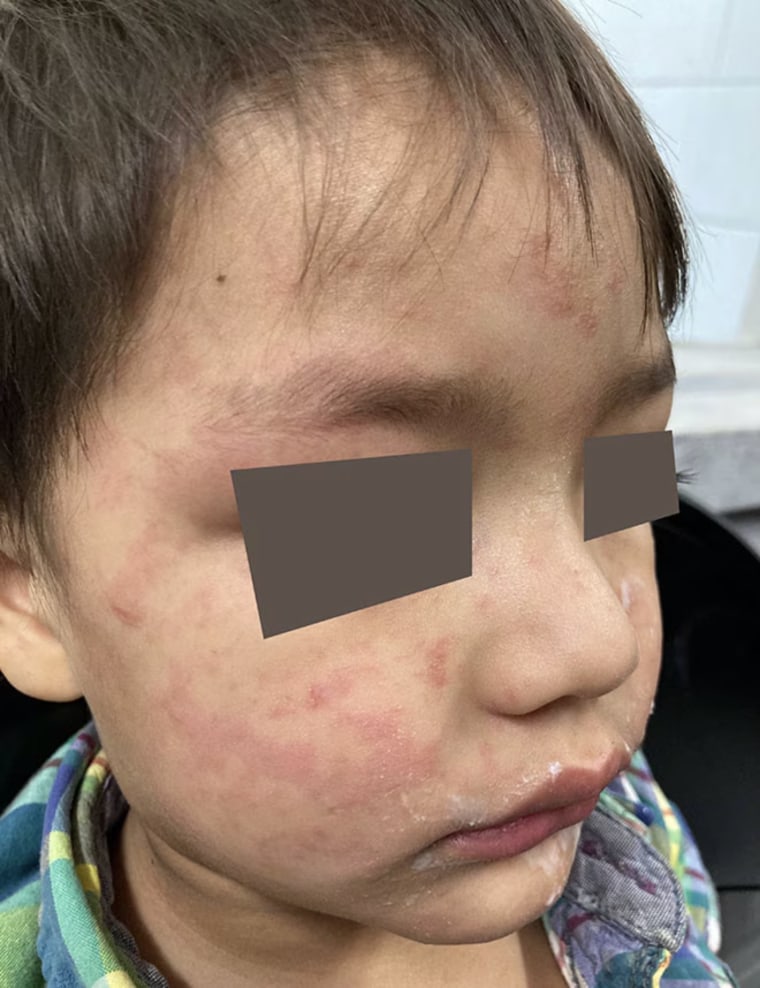
Babies and adults generally develop similar appearing rashes relating to measles.
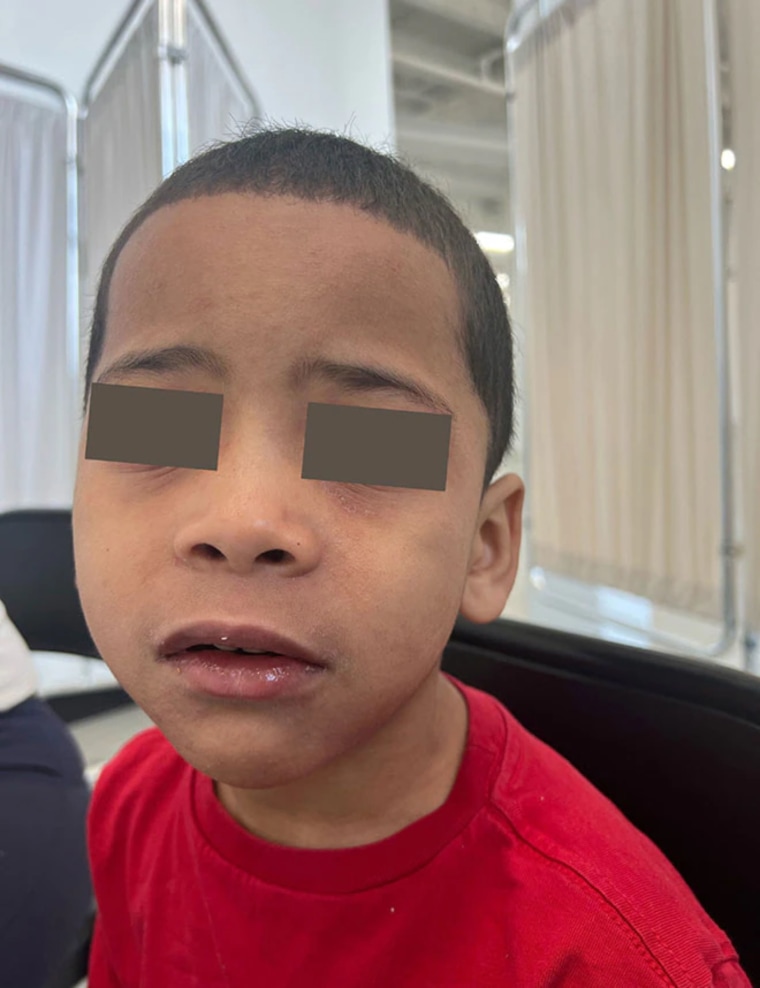
What illnesses can be mistaken for measles?
It can be difficult to know you have measles just by looking at the rash because several diseases cause rashes that resemble measles.
In children, these are often illnesses caused by viruses or bacteria like:
- Chicken pox
- Hand-foot-mouth disease
- Roseola
- Rubella
- Scarlet fever
- Mononucleosis
- Parvovirus
Adults may also develop a measles-like rash often due to a drug rash. These include:
- Penicillins
- Sulfonamides
- NSAIDS
- Anti-seizure medications
- Allopurinol
Other diseases that resemble measles include:
- Meningococcemia, a potentially lethal bacterial infection that often affects young adults.
- Rocky Mountain spotted fever, a severe tickborne infection endemic in the southeastern U.S.
- Kawasaki disease, an immune condition that affects children under age 5, which often causes heart complications.
- Dengue fever, Chikungunya or Zika virus, mosquito-borne infections that cause fever after recent international travel.
How do you confirm you have measles?
The only way to diagnose the illness is through lab tests.
A provider will typically order two tests: a throat or nasal swab combined with a blood test, according to the CDC.
The swabs are sent to the lab, which then is run through a machine that looks for copies of the virus. The diagnostic accuracy goes down the longer someone waits to get tested.
In the blood samples, the test is looking for acute antibodies that the body makes in response to an illness, but it’s important to get tested as soon as measles is suspected, as the antibody is best detected within three days after the rash starts.
How long does measles last?
Most people get better within 10 to 14 days. There is no cure, so treatment is directed at symptoms.
Symptoms generally start to appear one to two weeks after an exposure, so people often don’t know when they are first infected.
People then develop initially mild cold-like symptoms that last classically four days, followed by the hallmark red rash that peaks within several days, then gradually fades within seven to 10 days.
People are contagious for typically eight days — during the period four days prior to the rash and four days after.
When to contact a health care provider
People should always call their doctor if they think they were exposed or have a rash that looks like measles, especially if they are immunocompromised or pregnant, as measles can lead to low birth weight, premature birth and fetal death.
Measles can also cause complications, so look for these warning signs and then call a health professional:
- High fevers — especially if over 105 degrees Fahrenheit
- Signs of dehydration from diarrhea and vomiting
- Earache (an ear infection is one of the most common complications)
- Trouble breathing
- Severe headache, confusion or being uncharacteristically clumsy (as measles can cause brain inflammation called encephalitis)
What to know about the measles vaccine
The best way to protect yourself from measles is getting vaccinated with two doses of the MMR vaccine, which protects against measles, mumps and rubella, according to the CDC. Past research has shown the vaccine is safe and there is no link to autism, the CDC adds.
By injecting a live but weakened form of the virus into a person, the vaccine induces immunity (but does not cause illness) in a person with a normal immune system.
But those who immunocompromised may become sick with the vaccine, depending on how weak their immune system is, so it’s important to speak to your doctor about the risks and benefits before getting it. It is not recommended in pregnant women.
One dose of MMR vaccine is 93% effective at preventing measles, while two doses is 97% effective.
Most people are considered immune to measles if they have received two doses of MMR or have a blood test that shows evidence of immunity, though some who are fully immunized may still develop measles as their protection wanes over time, the CDC cautions.
Adults or adolescents who do not have evidence of immunity should receive at least one dose of MMR, but some who at higher risk for measles transmission should receive the two-dose series, separated 28 days apart, such as those who are health care personnel, students who plan to enter college or those who plan to travel internationally.
Schools in almost every state require a measles vaccine series before children enter kindergarten, per the CDC. Children should get vaccinated with the first dose of the MMR vaccine at 12-15 months of age, then a booster at 4-6 years old so they are immune before they enter kindergarten.
Can you get measles if you're vaccinated?
The vaccine is “highly protective,” the CDC emphasizes. “One dose of the MMR vaccine provides 93% protection against measles and two doses provide 97% protection,” a spokesperson explains.
That said, it is still possible to get measles if you are vaccinated. For example, five cases in the Texas outbreak were in vaccinated people. But it's important to note that people who are infected afer vaccination typically have much milder symptoms.
How to know if you're immunized against measles
If you're unsure if you're immune to measles, the CDC says there are three main ways to find out:
Lab test: Ask for a blood test that looks for antibodies against measles. If the test is positive, this means someone was naturally infected in the past or were previously vaccinated.
Birth year: Adults born before 1957 are presumed to be naturally protected against measles (because they were infected as a child).
Written documentation: Adults not at high risk for exposure and preschool-age children are considered immune if they have at least one documented dose of a MMR vaccine that was given on or after their first birthday. Adults high risk for exposure and school-age children need two documented doses of the MMR vaccine to be presumed immune.
